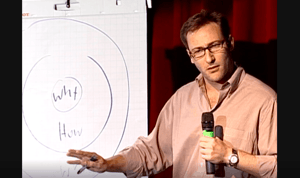The key to the success of great leaders, who throughout history have engaged and inspired millions of people, lies in a very clear model, “the world’s simplest idea”, which the writer and essayist Simon Sinek defines in this well-known TED talk dating back to 2009 as “the golden circle”.
“Every single person, every single organization on the planet knows what they do, 100 percent. Some know how they do it. But very, very few people or organizations know why they do what they do”. This is not a minor detail, but a fundamental difference: the leaders capable of inspiring others are aware of their true motivation and know how to transmit that motivation to people. They do not confine themselves to talking about what they do, but explain why they do what they do. And this is why they are successful.
However, what is more interesting is that, according to Sinek, his is not a simple, personal opinion, but a law that is rooted in biology and, more precisely, in how our brain is structured.
“The human brain is actually broken into three major components. Our newest brain, our Homo sapien brain, our neocortex, corresponds with the “what” level. The neocortex is responsible for all of our rational and analytical thought and language. The middle two sections make up our limbic brains, and our limbic brains are responsible for all of our feelings, like trust and loyalty. It’s also responsible for all human behavior, all decision-making, and it has no capacity for language”.
What does this mean? If we communicate in a rational and analytical manner, people can understand vast amounts of complicated information, but it doesn’t drive their behavior. In order to be successful, we have to take it to the next level and speak directly to the part of the brain that controls behavior, feelings and emotions (the part that has no linguistic capacity). The integration of these two planes enables people to “feel” the value of what we are proposing and makes what we do credible, attracting those that believe in the same values as us.
But that’s not all.
“Why is it important to attract those who believe what you believe? Because of something called the law of diffusion of innovation, which tells us is that if you want mass-market success or mass-market acceptance of an idea, you cannot have it until you achieve this tipping point between 15 and 18 percent market penetration, and then the system tips”.
According to Sinek, this rule applies to technological innovation, the business world and also to politics. An example? A great preacher like Martin Luther King was able to engage the masses, not because he went around saying what had to be changed in America, but rather by talking about what he believed in. He didn’t put forward a plan or a program. He said, “I have a dream”. And this is what made the difference.

